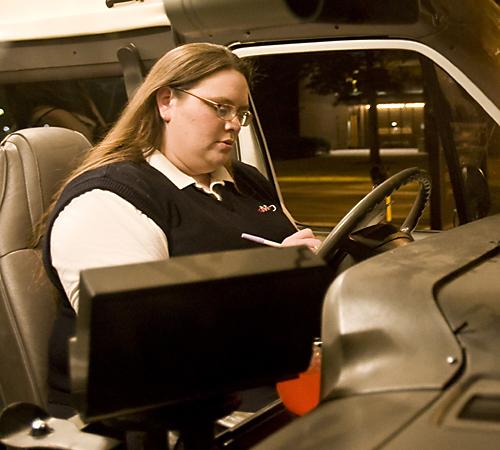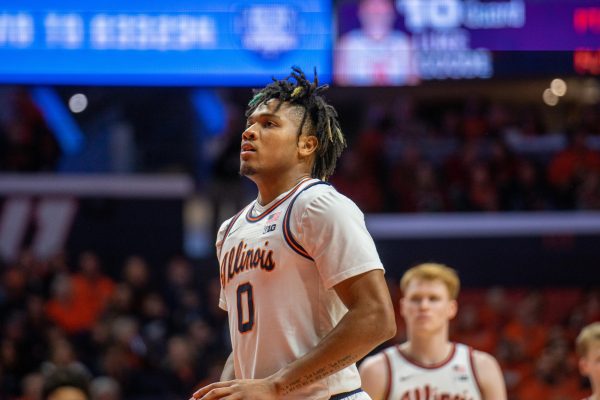SafeRides aids students’ travel

September 26, 2007
Sue Greer, SafeRides supervisor, spends her Thursday nights surrounded by ringing phones, video camera footage and route maps at the Champaign-Urbana Mass Transit District office, 1101 E. University Ave. Greer has the company of a dispatcher between the hours of 7 p.m. and 12:30 a.m. After the dispatcher leaves for the evening, Greer takes over and answers call after call with “MTD, can I help you?”
Greer, who has worked for the Mass Transit District (MTD) for 10 years, has seen the SafeRides program grow from its start as Nightrides in the mid-1990s, because of safety issues in the northwest area of campus, into its current position in the cell phone of many University students.
“A lot of people had been attacked, beaten and robbed so (the program) started with the North-West Direct which ran until 3 a.m. servicing that area,” Greer said.
When a professor was murdered by a University student in 1997, the SafeRides program became more of a priority.
“Safety became a bigger concern on campus, so we started SafeRides East, Southwest and Northwest,” Greer said.
The 22 Illini bus is also considered to be part of the SafeRides route in the evening which can be a faster mode of transportation.
“A lot of the time some people will call in and not understand that the (22 Illini) is part of the safe transportation program,” Greer said. “But they’re the same drivers, part of the same program and part of the whole package.”
Should a student not feel comfortable walking to their destination or waiting for the 22 Illini, SafeRides can provide an escort that will wait with the students or walk them home.
“We try to give students as many options as we can,” she said. If a student is outside of the boundary area or unable to use the service for any reason, Greer and other SafeRides dispatchers will give the callers a cab service phone number or suggest an alternative bus route.
Laura Chamberlain, SafeRides driver for three years and MTD employee for 10 years, believes that drivers have to be able to multi-task in order to drive and answer the phone. Chamberlain prefers driving SafeRides and specifically requests it every three months when MTD employees choose their schedules.
“I get to know my riders,” Chamberlain said. “Some of the girls I have been picking up for several years, they’re like siblings to me.”
Chamberlain usually drives the older vans on the route, armed with a caffeinated beverage, two cell phones and other miscellaneous items to get her through the shift from 8:30 p.m. to 5 a.m.
“I was always kind of a night owl anyway,” she said.
Chamberlain’s father was a driver for SafeRides when the program first began and she has noticed a distinct advantage to having a dispatcher mediate phone calls between students and drivers.
“It’s nice because with rush times it can get pretty chaotic, the dispatcher allows pick-ups and drop-offs to be pre-scheduled during the rush period which makes the system more efficient,” she said. Dispatchers can also give information to drivers and contact students if they don’t arrive at their pick-up or drop-off location at their designated time.
“I think this program makes a huge difference,” Greer said. Her dispatcher for the evening, Dennis Larson, agreed. Larson, an MTD dispatcher and driver, coordinates the pick-up and drop-off locations for all van drivers, serving as a mediator between the drivers and the students.
The drivers for the current routes – Northwest, Southwest and East – have pick-ups and drop-offs dispatched depending on where the individual is located or needs to go. Every individual who uses the SafeRides service must call and arrange a ride prior to boarding a van.
The drivers have checkpoints every half-hour at the Illini Union, a stop shared by all three routes.
“Between 7 p.m. and 9 p.m. we have one van out covering the entire area,” Larson said. “Between 9 p.m. and 10:30 p.m. we have two vans and between 10:30 p.m. and 3 a.m. we have three vans in the area.”
The gradual addition of vans to the SafeRides routes allows for the system to remain efficient, even during the busy hours of bar closings.
“There are some abuses of the system that are to be expected with this kind of service,” Larson said. “But we provide a secure environment for students going to and from the campus. To work this job, you have to enjoy the students and believe in the service.”




 DI multimedia
DI multimedia


